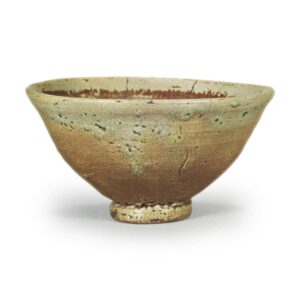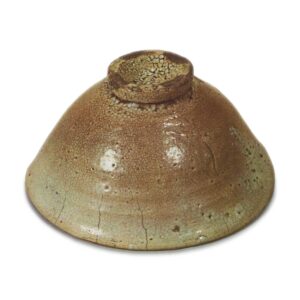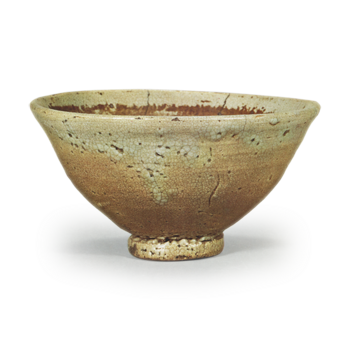

Collection: Nezu Museum
Height: 7.2 – 7.4 cm
Diameter: 13.7 cm
Outside diameter of foot ring: 4.5 cm
Height of foot ring: 1.0 cm
This tea bowl is considered to be one of Koido’s two masterpieces, along with the Rokujizo. In contrast to his hardness, this one also has a warm and elegant quality. Perhaps it is the wonder of the contrast between the male and female?
The name “Wasuremizu” is a signature of Kobori Enshu, and the meaning of the word “Wasuremizu” is a type of water that flows continuously in places that are out of sight, such as the grassland, and in the “Shika Waka Shu” (Anthology of Japanese Poetry) we can see a line such as “Sumiyoshi no asazawa Ono no bousui tae tae nara deafuyo shimona” (Volume 8). The wabi-sabi mood evoked by the word “wasui” (forgetting water) is truly captured in this teacup, which exudes a subtle hint of the color of love. Enshu’s signature is a clever way of singing the beauty of the tea bowl. With this signature, he is forever singing an endless poem of adoration and praise for the tea bowl with love.
There are few tea bowls that have such a perfect unity of form and glaze. It is elegant and wabi, yet also contains a moist, lustrous quality within. If expressed in words, it is truly the very essence of wasui, and perhaps more richly and subtly than a million elegant phrases, this tea bowl speaks of the sentiment of wasui.
As the name suggests, it is small, and compared to a well-made pot, it is thinly made, with finely turned wheel marks, and the foot is deeply incised, tapering from the foot to the rim.
The glaze is also warm and elegant, and while the overall color is a slightly reddish loquat color, the area around the rim is slightly bluish, and there is a fine pattern of plum blossoms on the inside and outside of the foot ring. The foot ring has four tripod-shaped feet.
The inside of the rim is heavily stained with tea, and there are four marks on the inside of the bowl. There are also several vertical cracks on the rim.
In terms of style, it differs from ordinary Ido ware, especially in the foot ring, but the clay also has a slightly lower iron content, and while the glaze is called “biwa-iro”, it is different from the usual Ido glaze, and has a slightly lost-glaze appearance. In general, the style, clay and glaze of these small wells, represented by the Wasuremizu ware, are clearly different from those of the large wells and the Aoido ware, and it seems that they are a highly skilled style with a strong tea-like flavor. Even so, while it cannot escape the criticism of being a little too subtle, it has produced tea bowls that arouse a delicate sense of beauty and are full of attention to detail, something that cannot be found in the Oido or Aoido styles.
Box inscription: Koshiro Enshu “Wasuremizu Koryo
Originally owned by Enshu, it was then passed on to Tsuchiya Sagami no Kami, and later became the property of Matsudaira Iga no Kami, the lord of Ueda Castle in Shinshu. After that, it was passed on to Akaboshi Yanosuke, and in 1917, it was sold at auction to Sakae Kanaya at the first auction of the family’s collection. It was later sold to Tsuchihashi Kihei, a tea utensil dealer in Kyoto, and then to Nezu Aoyama (Kaichiro), and in 1941, it became part of the Nezu Museum collection when the museum was established.



